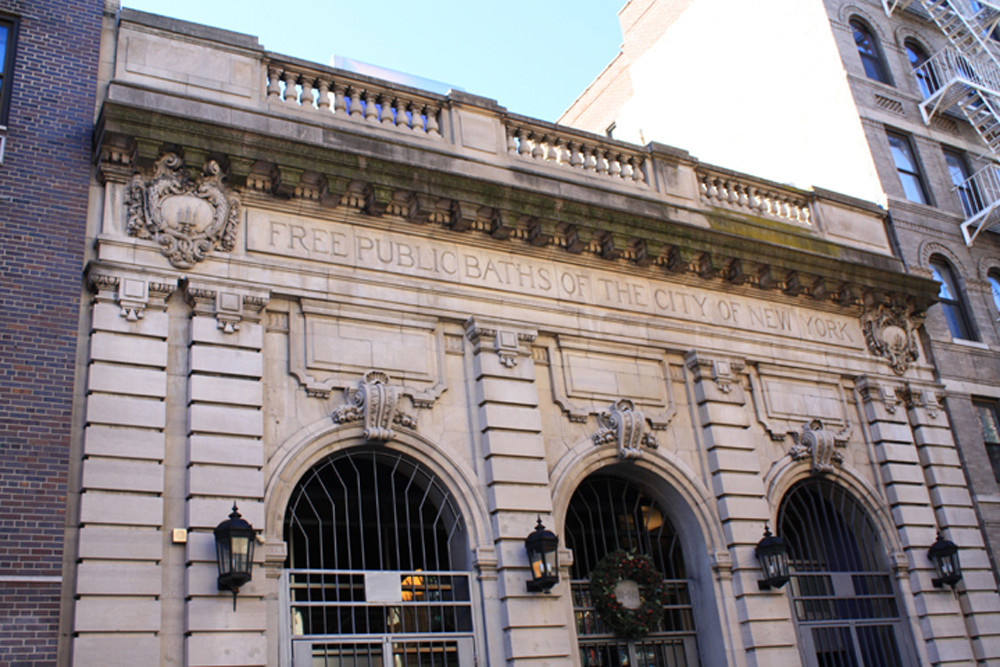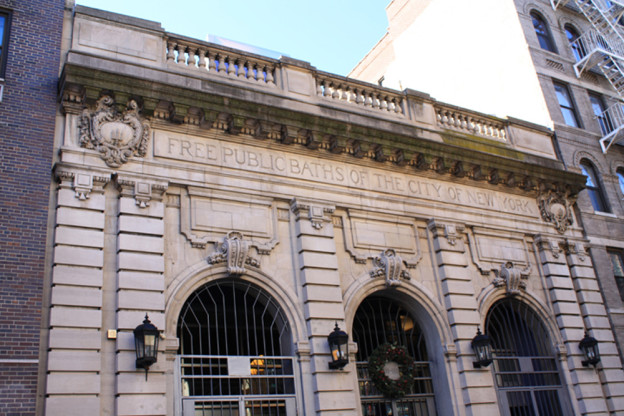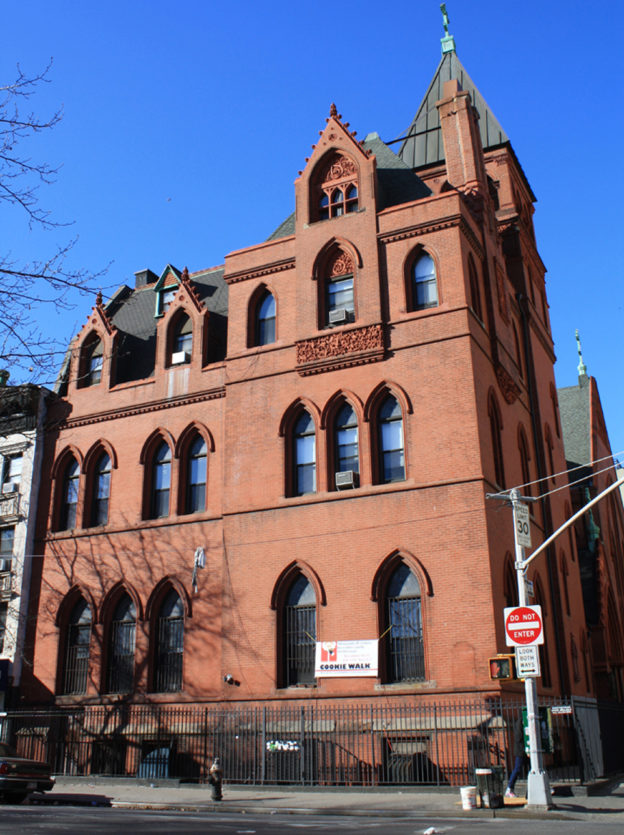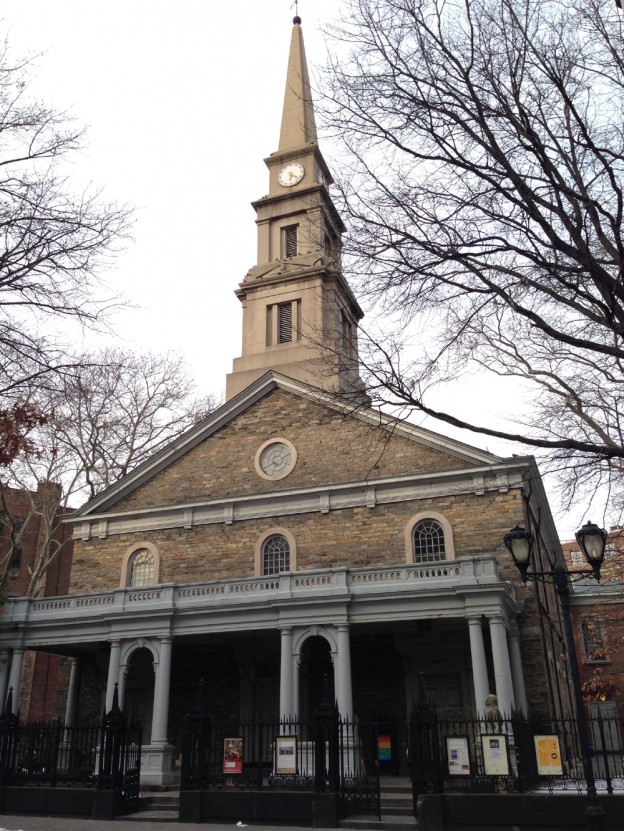538 East 11th Street , Arnold Brunner, 1904-05;
133 Allen Street, York & Sawyer, 1905|
During the 19th century, social reformers argued that the lack of bathing facilities was contributing to high mortality rates and that cleanliness would promote good citizenship in the growing immigrant population. The New York Association for Improving the Condition of the Poor opened the first public bathhouse at 141 Mott Street in 1852. The movement gained traction in the 1890’s, and 14 City-funded bathhouses opened between 1901 and 1914. The East 11th Street and Allen Street municipal bathhouses were both designed with limestone, Renaissance Revival façades. Though they now function as a photography studio and a church, respectively, their ornamental details – fish and tridents in the cartouches on East 11th Street and scallop shells in the terra-cotta medallions on Allen Street – hint at their former aquatic functions. 538 East 11th Street is a New York City Individual Landmark.
135-137 Second Avenue;
William Schickel, 1883-84|
In the 1840’s, this area became known as “Kleindeutschland” (Little Germany) for its large number of German immigrants. The Ottendorfer Library (now a branch of the New York Public Library) and German Dispensary (later renamed the Stuyvesant Polyclinic) were funded by German-American philanthropists Anna and Oswald Ottendorfer to uplift the minds and bodies of their fellow German-Americans. The buildings include Italian Renaissance Revival and Queen Anne-style details, with red brick, terra-cotta trim, arched windows and symbolic ornament: urns and books on the library and busts of famous physicians and scientists on the dispensary. By the end of the 19th century, Kleindeutschland began to diminish as Germans moved uptown to Yorkville and other immigrants moved in. This decline quickened after the 1904 General Slocum disaster, a paddle boat accident that claimed the lives of over 1,000 German parishioners of St. Mark’s Evangelical Lutheran Church. The Library is a designated New York City Individual and Interior Landmark, and listed on the State and National Register; the German Dispensary is a New York City Individual Landmark and listed on the State and National Register of Historic Places.
St. Mark’s Church in-the-Bowery, 131 East 10th Street;
John McComb, Jr., 1795-99; steeple: Ithiel Towne and Martin E. Thompson, 1828;
portico: attributed to James Bogardus, 1854;
parish hall: John C. Tucker, 1835; parish hall addition: James Renwick, Jr., 1861;
21 Stuyvesant Street, 1803-04;
44 Stuyvesant Street 1795;
112-128 East 10th Street, attributed: James Renwick, Jr., 1861;
23-35 Stuyvesant Street, attributed: James Renwick, Jr., 1861|
The St. Mark’s Historic District encompasses portions of East 10th Street and Stuyvesant Street between Second and Third Avenues, as well as the campus of St. Mark’s Church in-the-Bowery, Manhattan’s oldest site of worship. Stuyvesant Street was originally a lane separating two farms purchased in 1651 by Peter Stuyvesant, Governor of New Amsterdam. In 1787-93, Peter’s great-grandson, Petrus, laid out Stuyvesant Street and donated the land and funds for St. Mark’s Church. Located on the site of a 1660 chapel, under which Peter Stuyvesant and his descendants were buried, the present structure has a Georgian fieldstone body, Greek Revival steeple, and Italianate cast-iron portico. The district’s rowhouses date to the mid 19th century, constructed in elegant variations of the Italianate and Greek Revival styles. Referred to as “Renwick Triangle,” 112-118 East 10th Street and 23-25 Stuyvesant Street were designed by famed church architect James Renwick, Jr. The oldest houses on the street are 21 and 44 Stuyvesant Street, which Petrus built for his daughter Elizabeth and son Nicholas, respectively. When the City mandated a street grid adhering to Manhattan’s axis, St. Mark’s petitioned to keep Stuyvesant Street’s due east-west configuration because of its burial ground location. Thus, small triangles were created where Stuyvesant Street abuts East 9th Street, East 10th Street and Third Avenue. Each site is located in the St. Marks Hisotric District. The St. Mark’s Church in-the-Bowery is a New York City Individual Landmark and listed on the State and National Register of Historic Places. 21 Stuyvesant Street, is also listed on the State and National Register of HIstoric Places.
189 Second Avenue,;
Harrison G. Wiseman, 1925-26|
This part of Second Avenue was once referred to as the “Yiddish Rialto” for its many theaters catering to Jewish immigrants, for whom theater was a popular form of entertainment and an important cultural institution. The Moorish Revival structure was built for Brooklyn lawyer and civic leader Louis N. Jaffe to house the Yiddish Art Theater company, which ultimately only held four seasons here. Subsequently, it functioned as a Yiddish playhouse and theater until being converted to a cinema in 1988. The Former Yiddish Art Theater is a designated New York City Individual and Interior Landmark and listed on the State and National Register of Historic Places.





